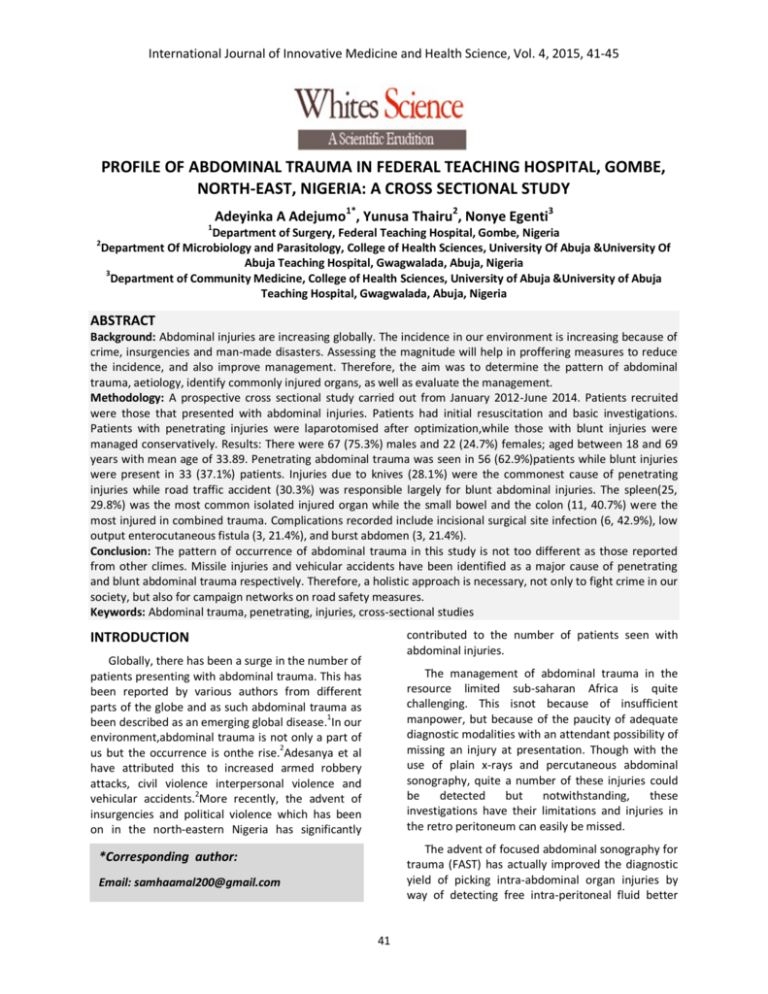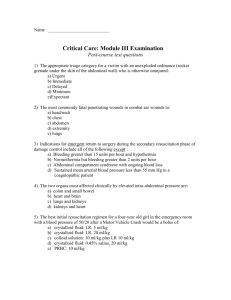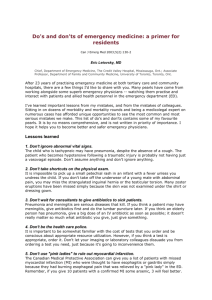profile of abdominal trauma in federal teaching hospital, gombe
advertisement

International Journal of Innovative Medicine and Health Science, Vol. 4, 2015, 41-45 PROFILE OF ABDOMINAL TRAUMA IN FEDERAL TEACHING HOSPITAL, GOMBE, NORTH-EAST, NIGERIA: A CROSS SECTIONAL STUDY 1 2 Adeyinka A Adejumo1*, Yunusa Thairu2, Nonye Egenti3 Department of Surgery, Federal Teaching Hospital, Gombe, Nigeria Department Of Microbiology and Parasitology, College of Health Sciences, University Of Abuja &University Of Abuja Teaching Hospital, Gwagwalada, Abuja, Nigeria 3 Department of Community Medicine, College of Health Sciences, University of Abuja &University of Abuja Teaching Hospital, Gwagwalada, Abuja, Nigeria ABSTRACT Background: Abdominal injuries are increasing globally. The incidence in our environment is increasing because of crime, insurgencies and man-made disasters. Assessing the magnitude will help in proffering measures to reduce the incidence, and also improve management. Therefore, the aim was to determine the pattern of abdominal trauma, aetiology, identify commonly injured organs, as well as evaluate the management. Methodology: A prospective cross sectional study carried out from January 2012-June 2014. Patients recruited were those that presented with abdominal injuries. Patients had initial resuscitation and basic investigations. Patients with penetrating injuries were laparotomised after optimization,while those with blunt injuries were managed conservatively. Results: There were 67 (75.3%) males and 22 (24.7%) females; aged between 18 and 69 years with mean age of 33.89. Penetrating abdominal trauma was seen in 56 (62.9%)patients while blunt injuries were present in 33 (37.1%) patients. Injuries due to knives (28.1%) were the commonest cause of penetrating injuries while road traffic accident (30.3%) was responsible largely for blunt abdominal injuries. The spleen(25, 29.8%) was the most common isolated injured organ while the small bowel and the colon (11, 40.7%) were the most injured in combined trauma. Complications recorded include incisional surgical site infection (6, 42.9%), low output enterocutaneous fistula (3, 21.4%), and burst abdomen (3, 21.4%). Conclusion: The pattern of occurrence of abdominal trauma in this study is not too different as those reported from other climes. Missile injuries and vehicular accidents have been identified as a major cause of penetrating and blunt abdominal trauma respectively. Therefore, a holistic approach is necessary, not only to fight crime in our society, but also for campaign networks on road safety measures. Keywords: Abdominal trauma, penetrating, injuries, cross-sectional studies contributed to the number of patients seen with abdominal injuries. INTRODUCTION Globally, there has been a surge in the number of patients presenting with abdominal trauma. This has been reported by various authors from different parts of the globe and as such abdominal trauma as been described as an emerging global disease.1In our environment,abdominal trauma is not only a part of us but the occurrence is onthe rise.2Adesanya et al have attributed this to increased armed robbery attacks, civil violence interpersonal violence and vehicular accidents.2More recently, the advent of insurgencies and political violence which has been on in the north-eastern Nigeria has significantly The management of abdominal trauma in the resource limited sub-saharan Africa is quite challenging. This isnot because of insufficient manpower, but because of the paucity of adequate diagnostic modalities with an attendant possibility of missing an injury at presentation. Though with the use of plain x-rays and percutaneous abdominal sonography, quite a number of these injuries could be detected but notwithstanding, these investigations have their limitations and injuries in the retro peritoneum can easily be missed. The advent of focused abdominal sonography for trauma (FAST) has actually improved the diagnostic yield of picking intra-abdominal organ injuries by way of detecting free intra-peritoneal fluid better *Corresponding author: Email: samhaamal200@gmail.com 41 International Journal of Innovative Medicine and Health Science, Vol. 4, 2015, 41-45 than visceral organ injury in blunt abdominal trauma.3However, FAST is not yet available in the study centreas at the time of this study,and we still therefore rely on the radiologist sonographic assessment using the usual percutaneous sonography. study. Patients who had laparotomies outside the study centre and were referred on account of complications were excluded. Patients were adequately optimized at admission and had relevant basic investigations done. Generous analgesia was given with broad spectrum antibiotics. Other injuries were treated appropriately(viz chest tube insertion, splintage of fractures and dressing of superficial wounds). Blood transfusion was done where indicated and tissue perfusion wasassessed to be adequate at 0.5ml/kg/hr before surgery was performed, or patient admitted for conservative measures. Clinical information was entered into a proforma designed for the study, and data analysis was done using Epi Info version 3.5.1. Diagnostic peritoneal lavage(DPL) is also a good and reliable way of ascertaining organ injuries and detecting intraperitoneal bleeding,but this is not without its limitations as it is non-specific, time consuming and can miss out retroperitoneal injuries.4The limitations of the DPLhaveactually paved way for diagnostic laparoscopy which gives a direct visualization of all the abdominal organs and offers an opportunity of carrying out therapeutic procedures as well. Again, this can only be achieved in a haemodynamically stable patient and requires 4 specialized training. RESULTS Table 1 summarizes the sociodemographic characteristics of the respondents.The ages of the patients in the study ranged from 18-69 years.The majority of the patients were aged 20-29 years (49.4%), while the mean age is 33.89±12.27 years. The study population comprised of 67 (75.3%) males and 22(24.7%) females, giving a male to female ratio of3.1: 1. Artisans made up the largest proportion (25.8%) while the professional class was the least (6.7%). In this environment, we do not have the luxury of using the computerized tomography (CT) scan and magnetic resonance imaging (MRI) to diagnose and stage organ injury for the purpose of either conservative or operative management as is the case in the developed world. These investigations are expensive and therefore not affordable to the teeming poor population. TheNational Health Insurance Scheme(NHIS) which was designed to prevent out of pocket expenses for patients, however, does not provide coverage for these hitech investigative modalities. Table 1: Sociodemographic pattern of the patients Frequency % Age group It therefore becomes imperative that clinicians in this sub region should rely on their clinical acumen as well as basic, cheap and readily available and affordable investigation modalities to make a diagnosis and also determine the extent of injuries in trauma patients. Thiswill not only save cost but also ensures prompt decision taking and prevent the progression of altered physiology which may lead to significant morbidity and /or mortality in the patient. < 20 20-29 30-39 40-49 50-59 60-69 Sex Males Females Occupation Artisan Unemployed Civil servants Students Professionals In order to appraise the pattern of abdominal trauma in the study centre, this study was carried out to assess the aetiology, pathology and management outcome in patients that sustained abdominal trauma. METHODOLOGY 6 44 20 9 7 3 6.7 49.4 22.5 10.1 7.9 3.4 67 22 75.3 24.7 23 21 21 18 6 25.8 23.6 23.6 20.2 6.7 Table 2a shows the proportion of penetrating abdominal trauma (PAT) and also of blunt abdominal trauma (BAT), with more cases of penetrating abdominal injuries (62.9%). This was a prospective cross sectional study conducted over a two and half year period; January 2012-June 2014. Patients with abdominal injuries either blunt or penetrating were recruited into the 42 International Journal of Innovative Medicine and Health Science, Vol. 4, 2015, 41-45 injuries are as shown in the table. Table 2a: Types of abdominal injuries Type of injury Frequency Penetrating Blunt 56 33 Table 5 shows the occurrence of combined injuries involving the abdominal organs, with injuries to the small bowel and colon the highest (40.7%). % 62.9 37.1 Table 5: Combined injured organs seen in the study Table 2b: Causes of abdominal injuries Aetiology Frequency % RTA* Knives/daggers Gunshot Fall from height* Arrows Sticks Cow horn 27 25 21 6 5 3 2 30.3 28.1 23.6 6.7 5.6 3.4 2.3 Combined organ injuries Frequency Small bowel + colon 11 Hepato-splenic 5 Mesentery+omentum+ Liver 3 Stomach+small bowel +spleen 3 Spleen +colon+RPH 2 Bladder+small bowel +RPH 2 Stomach +diaphragm 1 Table 2b illustrates that majority of abdominal injuries were as a result of RTA’s 27 (30.3%), while injuries from cow horns were the least, 2 (2.3%). Table 6: Surgical procedures done for various injuries in the study Procedures Fre% Table 3: Associated injuries with BAT Frequency % 33 29 26 23 1 100.0 87.9 78.8 69.7 6.1 quency Splenectomy Colostomy Closure of perforations Repair of lacerations RPA(small bowel) RPA (colon) Splenorrhaphy Splenectomy +colostomy being present in all patients with BAT. Others are head injuries seen in 87.9% of patients, fractures (involving the extremities) seen in 78.8% of patients, and chest injuries (both blunt and penetrating) seen in 69.7% of patients. 29 15 14 14 13 9 4 2 29.0 15.0 14.0 14.0 13.0 9.0 4.0 2.0 DISCUSSION The spleen was the most common organ injured as an isolated injury as seen in 25 (29.8%) patients, followed by retroperitoneal haematoma seen in 17 (20.2%) patients. Others organs involved in isolated Table 4 : Isolated injured organs Isolated organ injured Frequency Spleen 25 RPH 17 Small bowel 16 Colon 13 Liver 7 Diaphragm 3 Omentum 1 mesentery 1 40.7 18.5 11.1 11.1 7.4 7.4 3.7 Table 6 illustrates the various surgical procedures carried out on the injured organs; with splenectomy being the most common procedure performed (29.0%), followed by colostomy (15.0%). Table 3 shows various injuries associated with blunt abdominal trauma, with soft tissue injuries Associated injuries (with BAT) Soft tissue injuries Head injuries Fractures Thoracic Genitourinary % Abdominal trauma has been described as a disease in evolution,and the incidence in our environment is expected to increase based on the continuous evolution of crime and perennial problems of unemployment.1,2Young people have been found to be affected more as they are the mobile population who move from one place to the other in order to cater for their family needs.5 A similar spectrum was observed in this study as majority (64, 71.9%) of the patients in this study are in the 2nd and 3rd decade of life and this finding conforms to observations made by other 6,7 authors. More males (75.3%)were affected than females, with a male to female ratio of 3.1:1 and by % 29.8 20.2 19.1 15.5 8.3 3.6 1.2 1.2 43 International Journal of Innovative Medicine and Health Science, Vol. 4, 2015, 41-45 occupation, artisans and civil servants were more affected. This is in keeping with reports from various 3,7,8,9,10 studies. being freely mobile, and as it occupies a large area in the abdomen makes it susceptible to injuries. The spleen was the most common organ injured as an isolated injury. This was seen in 25 (29.8%) patients andsplenectomy was the commonest surgical procedure carried out on these patients (29.0%). A similar scenario was reported in two 13 14 separate studies by Nyongoleet al andDogoet al. Penetrating abdominal trauma (PAT) accounted for the majority(62.9%) of the total patients seen while blunt abdominal trauma (BAT) accounted for 37.1%. This is in keeping with the reports of other workers that reported more of PAT.6,10,11However,reports from some studies had a contrary view as more BAT were 7,8,12,13 observed. The predominance of PAT from this study and that reported by Edino from Kano, Nigeria may be attributable to the social, ethno-religious and political violence that has been ongoing in Northern Nigeria for quite some time. Associated injuries seen with BAT in this study include soft tissue injuries (abrasions, lacerations, frictional burns) which was present in all the patients, followed by traumatic brain injuries 29 (87.9%), fractures 26 (78.8%) and chest injuries 23 9 (69.7%).Udoeyop and his colleague from Calabar, Nigeria as well reported the presence of other systemic injuries in their patients. However, the frequency was much less compared to the observation in this study. Majority (57.6%)of patients with BAT were managed non-operativelywhile 14 (42.4%) had laparotomies, with negative findings in 4(28.6%) patients and retroperitoneal haematomas with associated small bowel perforations in the remaining 10(71.4%) patients. This is contrary to what Smith and his colleagues reported, in which 65% of their patients who sustained BAT had laparotomies.1 A total of 29 patients had associatedtraumatic brain injuries; out of which 5(17.2%) patients were referred to neurosurgical centres, 4(13.8%) had targeted burrhole for evacuation of haematomas, while the remaining 20(69.0%)were managed conservatively. Of the 23 patients with associated chest injuries, 9(39.1%) patients were managed conservatively, 11(47.8%) had closed under water sealed thoracostomy tube insertion for the drainage of haemothorax and haemopneumothorax, while 3(13.0%) had thoracotomy. The fractures were managed by the orthopaedic surgeons, while the urology team was involved in the management of the genitourinary injury(renal) conservatively. The cause of injuries in PAT in this study included knives 25 (28.1%), followed by gunshots 21 (23.6%). This is contrary to the reports by other authorsthat reported gunshots as the most common cause of PAT in their separate studies.9,14 Other aetiological factors for PAT in this study include arrows (5.6%),cowhorn injury (2.3%) and impalement injuries with sticks (3.4%). The commonest cause ofBAT in this study was road traffic accident (RTA) seen in 27 (30.3%) patients and fall from heights 6 (6.7%). Other authors as wellhave reported RTA to be the 7, commonest cause of BAT in their different studies. 14, 15, 16 This can be blamed on poor road infrastructure, bad driving habits and noncompliance of motorists with standard safety measures. The commonest complication encountered was incisional SSI 6 (42.9%). Ayoadeet al7 from Sagamu, South-West Nigeriaas well observed SSI as the commonest complication in their study. Other complications observed include low output enterocutaneous fistula 3 (21.4%), intra-abdominal abscess 2 (14.3%), and burst abdomen 3 (21.4%). Re-do procedures were carried out to treat these complications or as part of the treatment component for the patients. These include colostomy reversal 17 (65.4%) patients, drainage of intra-peritoneal abscess 2 (7.7%) patients,resection and anastomosis for enterocutaneous fistula 1(3.9%) patient, and secondary wound closure6 (23.1%) patients. The gastrointestinal tract was far more affected in both PAT and BAT, with injuries to the spleen, small bowel, colon, liver, stomach and diaphragmoccurring either as isolated or combined injuries. Suleet al17 from Jos, Nigeria has earlier reported this, and his findings were corroborated by the reports of other workers who similarly observed that the GIT, especially the small bowel, is more 3,9,10,16 involved in abdominal trauma. The small bowel Seven (7.9%) patients died during the first week of admission. This occurred in four patients with blunt abdominal injury that exploration was delayed 44 International Journal of Innovative Medicine and Health Science, Vol. 4, 2015, 41-45 for 72 hours with intra-operative finding of small bowel and splenic injury that were missed at presentation, whilethe remaining three patients died of complications associated with brain injuries. The observed mortality rate from this study is not too different from the reports from other climes Munns16 from Australia reported a mortality rate of 7 5.9%, Ayoade from South-West Nigeria reported a rate of 13%, while Udoeyop9 from South-South Nigeria reported a rate of 10.3%.The duration of hospital stay for these patients ranged between 9-42 days with a mean of 13±8.50 days. 5. 6. 7. CONCLUSION The pattern of abdominal injuries seen is not too different as those reported by other authors. Public enlightenment and provision of gainful employment will to a large extent prevent our youth from engaging in social vices. 8. A strategic campaign for all road users with respect to safety guidelines and conduction of periodic assessment to appraise the efficacy of the training will greatly reduce the incidences of vehicular accidents. This will involve the trauma specialists, working in conjunction with government agencies like the police and road safety corps. 9. 10. Concerted efforts are needed, in order to strengthen the National Health Insurance Scheme, so that every trauma investigation (especially CT, MRI, Laparoscopy, etc)be included in the Scheme. As such,bureaucratic bottlenecks at diagnostic level will be overcome and patients will receive optimal quality care. 11. 12. REFERENCES 1. 2. 3. 4. 13. Smith J, Caldwell E, D’Amours S, Jalaludin B, Sugrue M. Abdominal trauma: Adisease in evolution. ANZ J Surg. 2005; 75: 790-794. Adesanya AA, Afolabi IR, da Rocha-Afodu JT. Civilian abdominal gunshots wounds in Lagos. J. R Coll. SurgEdin. 1998; 43:230. Nnamonu MI, Ihezue CH, Sule AZ, Ramyil VR, Pam SD. Diagnostic value of abdominal ultrasonography in patients with blunt abdominal trauma. Niger J Surg. 2013; 19(2): 7378. Aduful HKA, Adu-Aryee NA, Anyanwu CH, Archanpong EQ, Yeboah ED, Dakorah TK. Management of the injured patient: Penetrating and Non-penetrating injuries. In Principles and Practice of Surgery including Pathology in the 14. 15. 16. 17. 45 Tropics. Badoe EA, Archampong EQ, da RochaAfodu JT (Eds), 4th ed. Accra: Ghana Publishing Corporation; 2009. 158-198. Osime CO, Oludiran OO. Penetrating abdominal injury cases admitted in University of Benin Teaching Hospital. Ann Biomed Sci.2004; 3(1-3): 39-44. Edino ST. Pattern of abdominal injuries in Aminu Kano Teaching Hospital, Kano. N. Postgrad. Med. J. 2003; 10: 56-59. Ayoade BA, Salami BA, TadeAO, Musa AA, Olawoye OA. Abdominal injuries in OlabisiOnabanjo University Teaching Hospital, Sagamu, Nigeria: Pattern and Outcome. Niger J Orthop Trauma. 2006; 5(2): 45-49. Chalya PL, Mabula JB. Abdominal trauma experience over a two-year period at a tertiary hospital in north-western Tanzania: a prospective review of 396 cases. TJHR. 2013; 15(4): 1-13. Udoeyop UW, Iwatt AR, Abdominal trauma in south-eastern Nigeria. Cent Afr J Med. 1991; 37: 409-415. Asuquo M, Umoh M, Nwagbara V, Ugare G, Agbor C, Japhet E. Penetrating Abdominal Trauma: Experience in a Teaching Hospital, Calabar,Southern Nigeria. IJCM.2012; 3: 426430. Musau P, Jani PG, Owillah FA. Pattern and outcome of abdominal injuries at Kenyatta National Hospital, Nairobi. EAfr Med J. 2006; 83(1): 37-43. Haan J, Kole K, Brunetti A. Non-therapeutic laparotomies revisited. Am J Surg. 2003;69:562565. Nyongole OV, Akoko LO, Njile IE, Mwanga AH, Lema LE. The pattern of abdominal trauma seen at Muhimbili National Hospital, Dar es Salaam, Tanzania. East Cent. Afr. J. Surg (online). 2013; 18(1): 40-47. Dogo D, Yawe T, Hassan AW, Tahir B. pattern of abdominal trauma in North Eastern Nigeria. Niger JSurg Res. 2000; 4: 48-51. Yusufu LMD, Sabo SY, Odigie VI. Blunt abdominal trauma in Zaria, Nigeria. SAJS. 2005; 43(2):46-47. Munns J, Richardson M, Hewett P. A review of intestinal injury from blunt abdominal trauma. ANZ J Surg. 1995; 65(12): 857-860. Sule AZ, Kidmas AT, Awani K, Uba F, Misauno M. Gastrointestinal perforation following blunt abdominal trauma. E Afr Med J. 2007; 84(9): 1-5.






